The Chicken Run is the next most expensive thing you will buy, next to chicken houses and is most likely to be the weakest link as far as predators like foxes are concerned.
In order to come up with a sensible sized run, you will need to ask yourself the following:
- How many chickens will I have? Always assume a couple more because it is a very addictive hobby and you will soon be tempted to add a couple more hens to your flock!
- What space do they need? There are guidlines but legally a battery hen has enough space…. so perhaps you should consider what a fair size run would be for them to move around in, scratch, dust bath, feed and drink and whether there is enough room for them to get away from another hen if pecked.
The run is there to contain your chickens but also to protect them from predators. We have a number of different chicken runs and I have used several designs over the years but every time I visit a friend who has lost chickens to the fox, they say the same things, either “I didn’t want to spend….” or “I didn’t have the time to…” and “the fox got in through here…”
So lets look at the options, you can pay for a chicken run that will cost you money or you can build a chicken run that will cost you in time but is less money!
Buying a Chicken Run
Most of the chicken runs that you can buy to fit onto a coop (or that are built into a coop) are rather small in my opinion. There is an answer to this though. Use this run for your girls when the weather is really bad or when there is a higher risk of predators but at other times, open the door and let them out!
The down side to this is that they will spoil a small garden over time with their scratching and dust baths, will eat some of your plants and will leave droppings on paths for you to step in! The good news is they get to free range and will be far happier and healthier hens, you can enjoy having them out and can limit their time out a little to allow the garden to recover. You can of course fence chickens into a certain area of the garden which can help if you have plants that you don’t want destroying.
An alternative to letting them out of their run is to use a portable run so you can move them around onto fresh grass at regular intervals. I have done this regularly with my young growers but be warned they soon spoil the ground and need moving every few days if the grass is going to have a chance to recover so make sure you get a house and run that’s easy to move on your own or with someone.
 When buying a run, you will need to look at the quality of the wire – small rectangular or square mesh wire is better because foxes can’t get their teeth in to tear at it.
When buying a run, you will need to look at the quality of the wire – small rectangular or square mesh wire is better because foxes can’t get their teeth in to tear at it.
Cheap rabbit wire can be quite thin (especially the cheaper, imported versions from Asia) and I have seen this torn open in weak spots, sadly enough for Mr. Fox to get through. If you decide to use rabbit wire then look for British made, galvanised wire. You certainly ‘get what you pay for’ here but it’s worth doing the job properly.
Latches or bolts to doors are important as well. Galvanised fittings will last years so it is worth paying for these. Screws need to be stainless steel so they don’t rust.
Foxes will dig under a chicken run. If you have problems with foxes during the daytime (or your chickens are not securely locked up in their house at night) then you will need to consider putting your run onto bricks so that Mr. Fox can’t dig underneath. You can put wood chips down inside the run so they can be changed regularly.
There are some smaller runs available that might be customisable to your coop.
Building a Chicken Run
If you are going to build a chicken run, you will need to spend less money but more time. You can of course build a small portable run, much like you would buy and the same things apply to this as I’ve mentioned above but often, people that are building a run go for a fixed run in the corner of the garden.
Rabbit wire is the most economical choice but do be careful with the quality of it. If it isn’t particularly thick, a determined fox will be able to tear at it to get in. a double layer around the lower half of the fence is best if the wire quality is poor.
Ensure that weak points such as where wire joins houses is securely stapled. These areas will need checking regularly for signs of wear and tear. If installed correctly, electric fences are very good at keeping foxes out but on occasions, I’ve seen a run with a fox unable to get out! Sadly the damage has already been done.
Electric fences are not always suitable for every back garden but even in an urban environment where there are people, you can use an electric wire around the top of a fence to stop foxes climbing over.
Chicken wire needs to be burried at least 6 inches with another couple of inches turned outwards but if the soil is loose, you may need to go down 9 inches or more.
A fox can run up a fence (don’t think of a fox being like a dog, they can move more like a cat and can jump and climb really-well) so unless your run has a wire roof, you will need to make the fence at least 6ft high and ideally sloping outwards at the top.
Gates should ideally be made from a solid mesh stapled to a sturdy frame. If this is not possible, at least make sure the gate cannot twist, allowing a predator to get through if pushed in the corners. A fox will easily get through a small hole. If you don’t believe me, go to my page on foxes and watch the film of the fox squeezing under the fence that’s just a few inches off the ground!
Another method of building a large chicken run is to build some ‘chicken run panels’. You can cut all of your wood in one go, with many pieces being the same size. Once you have produced enough panels, you can screw them together making a large run that’s easy to assemble. Keep the panels off the ground so they don’t rot, a brick base on a small strip foundation is perfect but I’ve seen people use rectangular posts on their side and (better) old railway sleepers buried in the ground.
How to Build a Chicken Run
Building a chicken run is really straight forward if you have some basic DIY skills and follow some of the guidance I have given above.
There are a number of chicken run designs that manufacturers use and a few other ‘home made’ runs that are successful. It is difficult to say when a chicken run becomes a ‘fenced off area’ (see my page on fencing chickens if you have a large area to fence off as a run). I tend to call both ‘the chicken run’.
Here, I am going to call the ‘chicken run’ an enclosure that could be 3 to 4 meters long, usually attached to the coop, rather than being ‘around’ the coop and is often covered over.
Start by drawing up the run how you see it in your mind. I like to make notes on my drawing as things pop into my head. This can save you significant time later on if you have thought it through before buying and cutting wood.
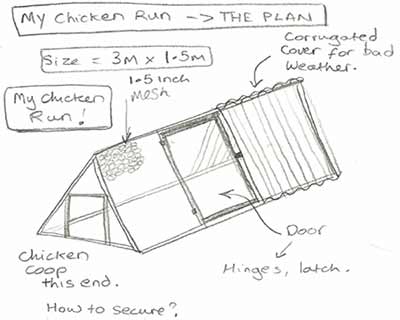 Draw a ‘close up’ of how you are going to make the joints of the chicken run, doors, joint wire and so on.
Draw a ‘close up’ of how you are going to make the joints of the chicken run, doors, joint wire and so on.
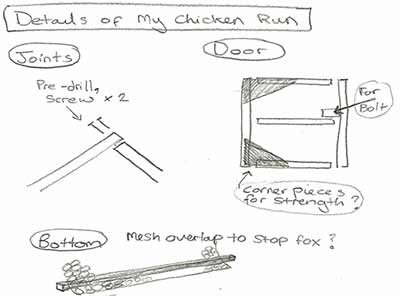 Build a ‘cutting list’ of pieces you will need to build the chicken run. Turn this into a ‘shopping list’ by working out how long your wood needs to be and what sort of thickness you will need. Add hinges, latches, screws, nails, poultry netting and staples to this.
Build a ‘cutting list’ of pieces you will need to build the chicken run. Turn this into a ‘shopping list’ by working out how long your wood needs to be and what sort of thickness you will need. Add hinges, latches, screws, nails, poultry netting and staples to this.
Go and buy your materials, allowing a small amount extra for mistakes!
Chicken Run Plans
One of the best sources of information on chicken runs has been looking through old poultry text books from the 1900’s onwards. These often give chicken house and run plans that have stood the test of time. Many have fold out pages with the plans on so providing you are happy to work in inches and feet, for a couple of searches on eBay and a few pounds, you can soon have quite a few chicken run plans.


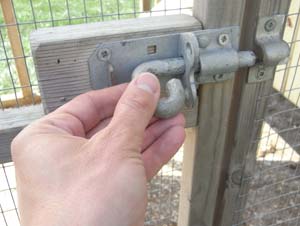

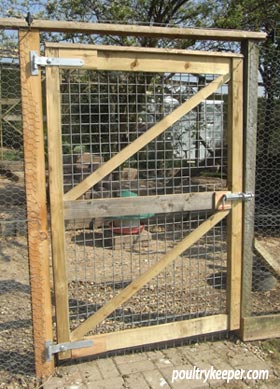
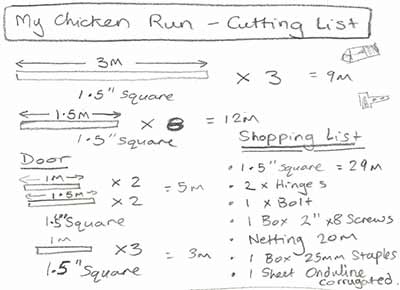
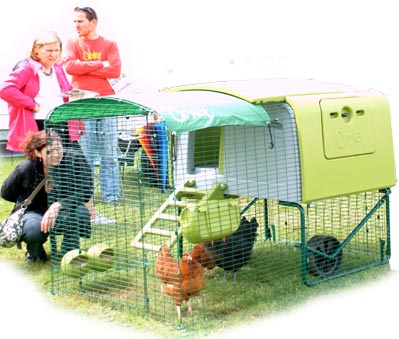
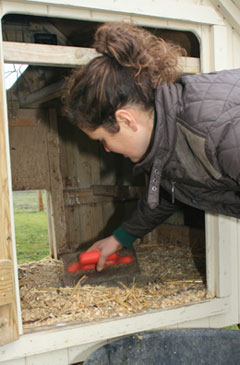

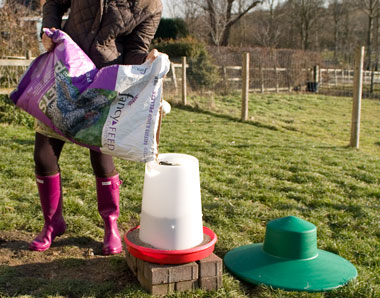
Hi, great article. I have an “L” shaped run (fenced in with 8′ chain link — former dog kennel) and I have the coop inside. I’m looking to cover the top so that I can let my girls out in the morning and lock them up at dusk. Will chicken wire on top be sufficient to protect my flock? I live in the city and don’t have to worry about foxes, etc…but stray cats are an issue. I’ve seen some people use poultry netting too, would that stop a determined cat?
Chicken wire should stop a cat – but I wouldn’t assume there aren’t any foxes. Cities are often the worst place for hungry foxes and you’ll see them in the early hours of the morning roaming the back streets and gardens picking up waste food and going through bins.
We just lost the last of our 16 hens out of a yard that was a 6′ chain link fence with bird netting over the top of it. We have no idea what got the chickens — no blood, no bodies, just feathers in one corner. We are totally sick over this. If we do it again, I guess they will be in a wire box.
Sounds like a weasel; they just love to kill. Same thing happened to my parent’s flock.
Hi there, great website with sime invaluable advice, thankyou:)
We are hoping to get some chickens in the not too distant future. We have a concrete area that we thought we could put the house and run on, which would be fairly large. Is wood chippings the best thing to line the floor of the run with? How deep should this be and how often should it be changed? We would hope to be able to let them out most days into a fenced off area of the garden when we are around, but during the winter on cold wet days, or even in the summer on the days we work, would they be happy enough to stay in the run? Sorry for all the questions, I have a whole heap but that will do for starters! Kind regards, Lynsey.
Hi Lynsey,
4 to 6 inches is usually about right – this is deep enough for them to scratch through. I guess about once a year is a good time to change it – but – it will depend on how many hens you have in the area and whether you clear away some of the muck from time to time.
Yes, you can shut them up while you’re out, however if they are kept too intensively for too long, boredom will set in and they will pick up vices such as feather picking and bullying. You can help them by leaving greens such as cabbages hanging in the run at a height that they need to jump to reach. This will keep them amused and give them exercise and vitamins in one!
Looking to get some rescue chickens and ducks soon and was hoping I could keep them in the sme enclosure, with a pond at one end. Is that a problem keeping them together???
No, but a few things need to be managed carefully and there must be enough space for them to go about their own business. It’s outside the scope of this website – but poultrykeeper.com has a good article called Can I keep Chickens and Ducks together.
Our duck lives with our chicken in perfect harmony. Got them all at a few days old and the duck mothers them and they listen to her. I would however making a few modifications, keep a pond or small shallow bin filled with clean water for your duck. Also, make sure all feeders, waterers etc are wide enough for her bill, i use homemade PVC ones with nipples and it works great and make the ramp into the coop about 4 inches wider for her to use. They are not quite as agile as chickens.
Ducks also appreciate company of their own sort so I would encourage you to find a friend for her 🙂
Good day, we real appreciate for such an informing work you guys are doing! What I needed to know is, how many layers am I supposed to rear in a run of 3,44m x 2m? The other thing is, I had that the ideal floor is wooden one isn’t? If they have started laying eggs would a wooden floor be of risks to damaging of eggs, as some of these hens usual they don’t go inside prepared places for laying eggs?
I appreciate your input in this regard!
3.44 x 2 isn’t very big – I would go for 2 or 3 hens.
A solid floor is no good for scratching (chickens most natural behaviour) so it’s normal to lay 4-6 inches of wood chip or similar for them to scratch in.
Chickens will normally want somewhere quiet and darkened to lay – a nest box inside the house with soft nesting material such as straw is ideal.
Hi, I’m looking for some advice if possible. I have been keeping 3 chickens free range in my garden for a couple of years. I lock them in their run before dark and then shut them in their house once they have taken themselves to bed. 2 of my chickens were taken by a fox? I presume, in the middle of the day a couple of days ago. I now only have one chicken left and I’m not sure what to do. I love keeping chickens but am moving in the next 4 months to a house that has a resident fox in the road and she has 5 young foxes with her, and they are often in what will be our garden. I’m not sure if I should give up keeping chickens and rehouse my last one, or start looking into keeping chickens in a fixed run in the new garden? The garden is large but sloped and has different levels and trees etc in odd places so would be difficult to move a run around. I was wondering about electric fencing and if I could use this and move it about? So very stuck on what to do, really considering giving up on keeping chickens as it is not fair to get them knowing about the foxes at our new house. Any advice would be appreciated, thank you.
It really depends on the situation – a large garden is well suited to an electric fence and they do work if installed correctly and the battery isn’t flat! More permanent than this is electric wires on insulators on the outside of the fence which is what I use covering 1/4 acre for the chickens.
On a smaller scale, a run is the only option and it can be a lot of work creating a secure chicken run. You can put an electric wire around the top or along the bottom on a run too if it’s a risk to help.
Keeping one chicken on her own isn’t kind (they are flock animals) so I would certainly try to find a couple more for her.
Hi
I also lost 2 chickens during the day recently. One last Wednesday which I replaced the following Saturday as I only had one hen left and then she disappeared without trace last Monday. I think I will be buying a galvanised chicken run (I will need help to move it as it is about 60kg) but cannot think of an alternative. Poor Jellybean is on her own (though she was not happy about her new “friend”) so maybe not that unhappy after all. Really just wanted to say that after going through all the possibilities, I think they were taken by someone and not something. They were fine both days when I left for work but gone when I got home from work. I have been told that foxes do not leave any alive, they will kill them all even if they do not take them. could this be a possibility for you?
If a fox is disturbed or nervous about being caught, they will just grab a chicken and run.
Near where I live there is a family with a flock of around 10 chickens, they are always escaping from their enclosure, which is 6ft high heavy duty cross-cross wire fencing all the way around. It certainly looks like it ought to be chicken-proof, yet they still manage to get out (not all at once, usually just one or two now and then).
Is it possible your chickens escaped?
My run fence is 6 ft high and the chickens could escape if they wanted to without too much effort, but my run is 1700+ sq ft so they don’t bother. I’ve had to bury my wire into the ground about 6 inches and then barbed wire beneath that as I caught a fox one day trying to dig underneath.